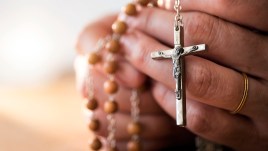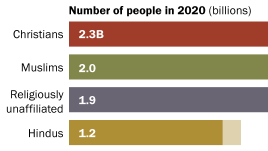
How religious is your state?
Explore our interactive database to find out how religious adults are in your state based on service attendance, prayer, belief in God, and importance of religion.
Numbers, Facts and Trends Shaping Your World
Explore our interactive database to find out how religious adults are in your state based on service attendance, prayer, belief in God, and importance of religion.
All
Publications
< < Return to the report.
Senior Researcher Brian J. Grim talks about the Pew Research Center’s restrictions on religion studies at the April 2013 TEDx ViaDellaConciliazione conference at the Vatican. https://www.youtube.com/embed/cQvDUTOOkiI Related Resources: Slides Arab Spring Adds to Global Restrictions on Religion TEDx ViaDellaConciliazione website TEDxViaDellaConciliazione Youtube page
While the date of the Hindu New Year varies by region and custom, many Hindus celebrate in mid-April at home and in temples. According to a 2012 survey of Asian Americans, 85% of Asian American Hindus attend worship services at a temple at least a few times a year, and 78% have a religious shrine in their home.
Between 2010 and 2012, lawmakers in at least 32 states introduced bills to ban state courts from considering foreign or religious laws in their decisions.
Across the U.S., religious courts operate on a routine, everyday basis. How do some of the country’s major Christian traditions and other religions – including Islam, Judaism, Buddhism and Hinduism – decide internal matters and apply their religious laws?
On Monday, the Oklahoma Senate passed a bill intended to prevent the use of foreign law in state courts. The bill contains language from model legislation designed to limit the use of sharia, or Islamic law. A new interactive map details similar bills introduced or enacted in 32 states between 2010 and 2012.
In the early days of Pope Francis’ papacy, more than eight-in-ten U.S. Catholics (84%) say they have a favorable impression of the new pontiff, including 43% who express a very favorable view.
Nearly half of U.S. adults are connected to Catholicism. Read about going to Mass, Communion, confession and more.
Christians remain the largest religious group, and Muslims grew the fastest from 2010 to 2020. Read how the global share of Buddhists, Hindus, Jews and the religiously unaffiliated changed.
After years of decline, the U.S. Christian share now shows signs of leveling off. The new Religious Landscape Study explores trends in identity, beliefs and practices.
The Global Religious Futures (GRF) project is jointly funded by The Pew Charitable Trusts and The John Templeton Foundation. Here are some big-picture findings from the GRF, together with context from other Pew Research Center studies.









